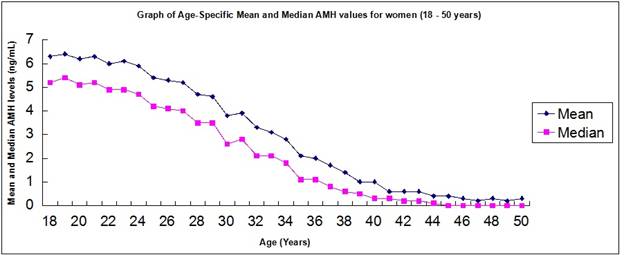All About Your AMH
Hi everyone! Thanks for joining me today as we discuss AMH (which is short for anti-Müllerian hormone).
Disclaimer: I am not a doctor, so please always discuss any health concerns with your doctor before making any decisions about your health.
Where does AMH come from?
AMH is actually produced before a baby is even born. A fetus contains a bipotential gonad, which can develop either a male (Wolffian) or female (Müllerian) reproductive tract. Male fetuses produce a lot of AMH (anti-Müllerian hormone) so the Müllerian duct does NOT develop. Female fetuses, on the other hand, do not produce a lot of AMH, and therefore the Müllerian duct does develop. The Müllerian duct gives rise to the Fallopian tubes, uterus, cervix, and upper part of the vagina.

Side note: the same applies to the Wolffian duct in males, except that testosterone drives the development of the Wolffian duct. Female fetuses do not produce a lot of testosterone, so the Wolffian duct does not develop. Male fetuses produce a lot of testosterone, so the Wolffian duct does develop. The Wolffian duct gives rise to the epididymis, vas deferens, seminal vesicles, and prostate gland.
AMH is later produced in females by cells in the follicles inside the ovaries. Recall that each follicle should contain an egg inside of it.
Why is AMH important?
We know that the follicles produce AMH, and we know that each follicle should have one egg inside of it. So, the more follicles (eggs) a woman has, the higher her AMH level should be.
The importance of AMH is its ability to estimate how many eggs a woman has in her ovaries (this is known as her ovarian reserve). It can also help predict how a woman will respond to IVF medications. Knowing this information, a healthcare provider can determine the best treatment protocol for each individual person.
How is AMH measured?
An AMH measurement can be obtained through a simple blood test.
AMH is measured in nanograms per milliliter (ng/mL) or, less commonly, pmol/L.
What do AMH results indicate?
There is some debate about what a “normal” AMH level is, and each IVF clinic may have slightly different ranges. As a general rule, the lower the AMH, the lower the ovarian reserve and chance of getting a lot of eggs in an IVF cycle. Women under 25 tend to have the highest AMH levels, but these levels begin to decline around this time.

Here are the general ranges for AMH results:
- 0.0-1.0ng/mL: low ovarian reserve. This is common in women who are a bit older (>40 years old) since egg numbers naturally decline over time (eggs are ovulated and degenerate each month, everyday exposure to chemicals/radiation can affect egg numbers, etc.). This is called a diminished ovarian reserve. Women with a very low AMH who are under 40 may have premature ovarian failure (but this requires a medical diagnosis!). It is possible to achieve a healthy pregnancy with a low ovarian reserve, particularly through IVF, but the chances of getting a lot of high-quality eggs (and embryos) are lower than normal.
- 1.0-3.5ng/mL: normal ovarian reserve. This number means that there are an average number of follicles (eggs). Women with normal AMH levels tend to respond well to IVF medications and have an average number of eggs retrieved. >3.5ng/mL: high ovarian reserve. This may seem like a good thing, but high AMH levels are typically indicative of PCOS (polycystic ovary syndrome). Women with PCOS have hormonal imbalances that can interfere with ovulation. If eggs cannot be ovulated, they may develop into cysts along the ovaries. Many women with PCOS have successful IVF cycles and healthy pregnancies, but severe PCOS can sometimes affect a woman’s overall fertility and the quality of her eggs.
Final Notes
Though AMH is a good indicator of your ovarian reserve, it’s only one factor when it comes to your overall fertility. For example, AMH levels cannot predict if your eggs have the correct amount of DNA or not. The final note is that your AMH is important, but don’t get discouraged if your results aren’t in the normal range. Many women with abnormal AMH levels have successful, healthy pregnancies. Your healthcare provider will be able to adjust your treatment protocol to help you achieve your best results based on your AMH (and other factors).
References:
1. https://www.yourhormones.info/hormones/anti-mullerian-hormone/
2. https://my.clevelandclinic.org/health/diagnostics/22681-anti-mullerian-hormone-test
3. https://advancedfertility.com/infertility-testing/amh-fertility-testing/
4. https://extendfertility.com/what-your-amh-level-really-means/